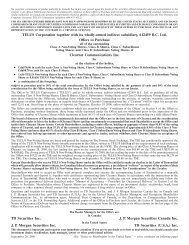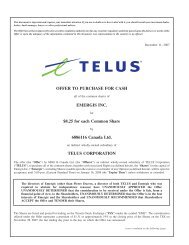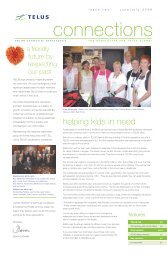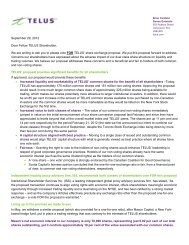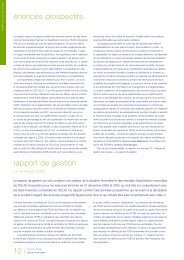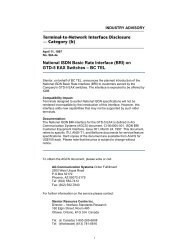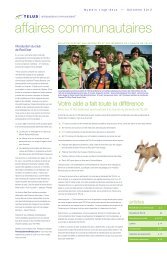Annual report - About TELUS
Annual report - About TELUS
Annual report - About TELUS
Create successful ePaper yourself
Turn your PDF publications into a flip-book with our unique Google optimized e-Paper software.
notes to consolidated financial statements<br />
2. SUMMARY OF SIGNIFICANT ACCOUNTING POLICIES<br />
The accompanying consolidated financial statements have been prepared in accordance with accounting principles<br />
generally accepted in Canada and in conformity with prevailing practices in the Canadian telecommunications industry.<br />
The preparation of financial statements in conformity with generally accepted accounting principles requires management<br />
to make estimates and assumptions that affect the <strong>report</strong>ed amounts of assets and liabilities and disclosure of contingent<br />
assets and liabilities at the date of the financial statements and the <strong>report</strong>ed amounts of revenues and expenses during<br />
the <strong>report</strong>ing period. Actual results could differ from those estimates.<br />
The term “Company” is used to mean <strong>TELUS</strong> Corporation and where the context of the narrative permits or requires,<br />
its subsidiaries.<br />
(a) Consolidation<br />
The consolidated financial statements include the accounts of the Company and all of the Company’s subsidiaries, of<br />
which the principal ones are <strong>TELUS</strong> Communications Inc., <strong>TELUS</strong> Communications (B.C.) Inc., Clearnet Communications<br />
Inc., <strong>TELUS</strong> Mobility Cellular Inc., ISM Information Systems Management (B.C.) Corporation, <strong>TELUS</strong> Services Inc.,<br />
Telecom Leasing Canada (TLC) Limited, and QuébecTel Inc. (70%).<br />
(b) Inventories<br />
Inventories are valued at the lower of cost and net realizable value, with cost being determined on an average cost basis.<br />
(c) Capital Assets<br />
Property is recorded at historical cost and, with respect to self-constructed property, includes materials, direct labour<br />
and applicable overhead costs. In addition, where construction projects exceed $20 million and are of a sufficiently<br />
long duration, an amount is capitalized for the cost of funds used to finance construction. This amount is included in<br />
the Consolidated Statement of Income as an offset against financing costs. The rate for calculating the capitalized<br />
financing costs is based on the Company’s one-year cost of borrowing. In 2000, $8.6 million of financing costs was<br />
capitalized ($1.6 million – 1999).<br />
When property, plant and equipment is sold by the Company, the historical cost less accumulated depreciation is netted<br />
against the sale proceeds and the difference is included in the Consolidated Statement of Income.<br />
(d) Depreciation and Amortization<br />
Assets are depreciated on a straight-line basis over their estimated useful life as determined by a continuing program of<br />
engineering studies. The composite depreciation rate for the year ended December 31, 2000, was 6.7% (7.8% – 1999).<br />
Acquired intangible assets are amortized on a straight-line basis over their estimated lives. The spectrum licenses and<br />
wireline subscriber bases are amortized over 40 years and wireless subscriber bases are amortized over 7–10 years.<br />
(e) Deferred Charges<br />
Deferred charges include deferred pension costs, more fully described in Note 17, deferred costs of issuing debt and<br />
deferred start-up costs. The deferred start-up costs are amounts relating to information services contracts that will be<br />
matched with related revenues. Discounts on long-term debt are amortized to interest expense on a straight-line basis<br />
over the remaining lives of the related liabilities. Where interest coupons and residuals are held as separate investments<br />
in sinking funds, discounts are amortized over the period to maturity or call date so as to produce a constant rate of<br />
return on the investments.<br />
(f) Goodwill<br />
Goodwill represents the excess of the cost of acquired businesses over the fair value attributed to the net identifiable<br />
assets. Goodwill is being amortized on a straight-line basis over 10 to 20 years. Management estimates the value of<br />
goodwill to be not less than the unamortized balance at December 31, 2000.<br />
> 66



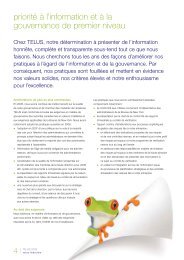
![DISK004:[98CLG6.98CLG3726]BA3726A.;28 - About TELUS](https://img.yumpu.com/16786670/1/190x245/disk00498clg698clg3726ba3726a28-about-telus.jpg?quality=85)
